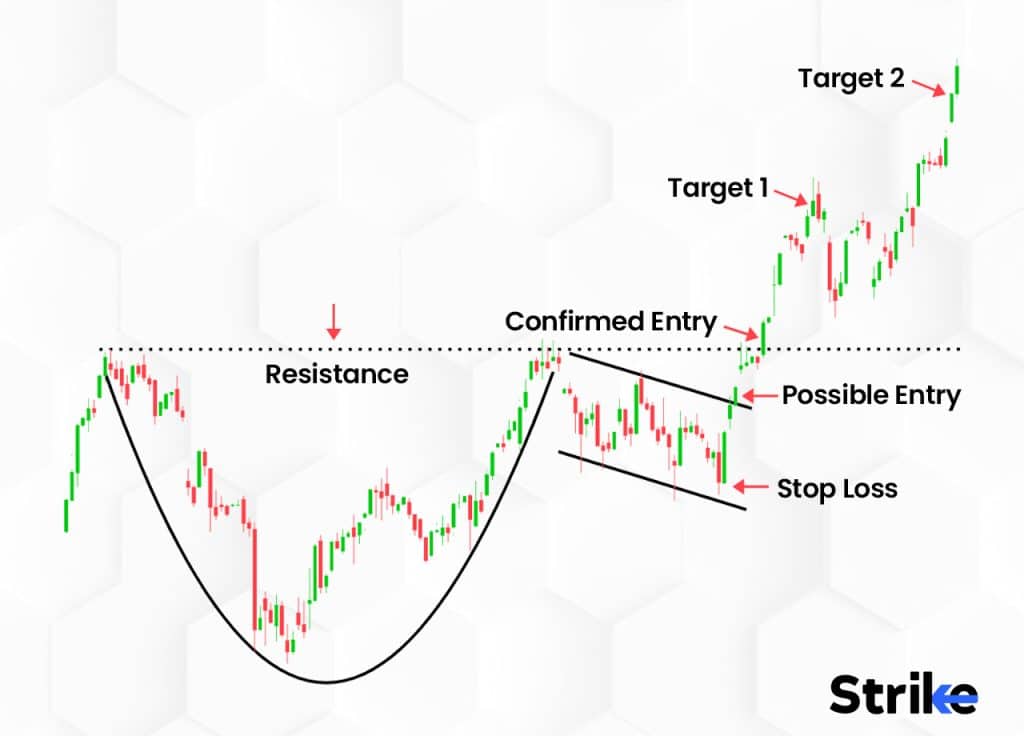Cup and Handle Chart Pattern kya hai:
Cup and Handle chart pattern aik technical analysis tool hai jo traders ko potential bullish trends identify karne main madad deta hai. Yeh pattern aik cup shape ki tara hota hai jo gradually lower points touch karta hai aur phir upar ki taraf rise karta hai. Cup ke baad aik chota handle banta hai jo consolidation phase ko represent karta hai. Jab yeh handle complete hota hai, to price breakout hoti hai aur upward trend start hota hai.

Cup Formation:
Cup formation start hoti hai aik sharp decline se jo rounding bottom banaata hai. Yeh bottom bohot smooth aur gradual hota hai jo buyers ki re-entry ko indicate karta hai. Cup ka duration kuch weeks se lekar months tak ho sakta hai. Yeh important hai ke cup ka bottom shallow ho, jo strong support level ko indicate karta hai.
Handle Formation:
Cup ke complete hone ke baad, price thori der ke liye consolidate hoti hai jo handle banata hai. Handle aik small downward sloping channel ya sideways movement hota hai. Yeh phase weak holders ko eliminate karta hai aur market ko next rally ke liye prepare karta hai. Handle ka duration usually cup se chota hota hai.
Breakout:
Jab handle complete hota hai, to price cup ke resistance level ko cross karti hai jo breakout signal hota hai. Yeh point buy signal generate karta hai kyun ke market aik new bullish trend main enter hoti hai. Breakout ki confirmation ke liye volume bhi zyada hona chahiye.
Entry and Exit Points:
Cup and Handle pattern main entry point breakout ke foran baad hota hai. Jab price resistance level ko cross karti hai aur volume bhi increase hota hai, to yeh strong buy signal hota hai. Exit point identify karne ke liye traders target price set karte hain jo cup ke depth ke equal ho sakta hai.
Stop Loss:
Stop loss set karna bohot zaroori hai taake unexpected price movements se bach sakein. Handle ke bottom ya cup ke bottom ke thodi neeche stop loss set karna aik safe strategy hoti hai.
Application in Forex Trading:
Forex trading main Cup and Handle pattern currency pairs ke long-term trends identify karne main madadgar hota hai. Yeh pattern high probability trades generate karta hai aur forex market ki volatility ko effectively handle karta hai.

Is tarah Cup and Handle pattern ko identify karke, traders apni trading strategy ko enhance kar sakte hain aur profitable trades execute kar sakte hain.
Cup and Handle chart pattern aik technical analysis tool hai jo traders ko potential bullish trends identify karne main madad deta hai. Yeh pattern aik cup shape ki tara hota hai jo gradually lower points touch karta hai aur phir upar ki taraf rise karta hai. Cup ke baad aik chota handle banta hai jo consolidation phase ko represent karta hai. Jab yeh handle complete hota hai, to price breakout hoti hai aur upward trend start hota hai.
Cup Formation:
Cup formation start hoti hai aik sharp decline se jo rounding bottom banaata hai. Yeh bottom bohot smooth aur gradual hota hai jo buyers ki re-entry ko indicate karta hai. Cup ka duration kuch weeks se lekar months tak ho sakta hai. Yeh important hai ke cup ka bottom shallow ho, jo strong support level ko indicate karta hai.
Handle Formation:
Cup ke complete hone ke baad, price thori der ke liye consolidate hoti hai jo handle banata hai. Handle aik small downward sloping channel ya sideways movement hota hai. Yeh phase weak holders ko eliminate karta hai aur market ko next rally ke liye prepare karta hai. Handle ka duration usually cup se chota hota hai.
Breakout:
Jab handle complete hota hai, to price cup ke resistance level ko cross karti hai jo breakout signal hota hai. Yeh point buy signal generate karta hai kyun ke market aik new bullish trend main enter hoti hai. Breakout ki confirmation ke liye volume bhi zyada hona chahiye.
Entry and Exit Points:
Cup and Handle pattern main entry point breakout ke foran baad hota hai. Jab price resistance level ko cross karti hai aur volume bhi increase hota hai, to yeh strong buy signal hota hai. Exit point identify karne ke liye traders target price set karte hain jo cup ke depth ke equal ho sakta hai.
Stop Loss:
Stop loss set karna bohot zaroori hai taake unexpected price movements se bach sakein. Handle ke bottom ya cup ke bottom ke thodi neeche stop loss set karna aik safe strategy hoti hai.
Application in Forex Trading:
Forex trading main Cup and Handle pattern currency pairs ke long-term trends identify karne main madadgar hota hai. Yeh pattern high probability trades generate karta hai aur forex market ki volatility ko effectively handle karta hai.
Is tarah Cup and Handle pattern ko identify karke, traders apni trading strategy ko enhance kar sakte hain aur profitable trades execute kar sakte hain.


تبصرہ
Расширенный режим Обычный режим